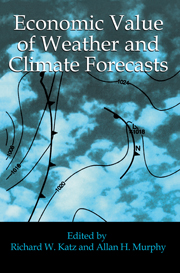2 - Forecast verification
Published online by Cambridge University Press: 27 October 2009
Summary
Introduction
Forecast verification has had a long, colorful, and occasionally controversial history. The first substantial developments in verification methods were occasioned by the publication of a paper by J.P. Finley (Finley, 1884), in which he summarized some results of an experimental tornado forecasting program. As a measure of forecasting success, Finley calculated the sum of the percentages of correct forecasts of tornadoes and no tornadoes (multiplied by 100) and reported a percentage correct value of 96.6%. Finley's paper attracted the attention of several individuals (e.g., Doolittle, 1885; Gilbert, 1884; Peirce, 1884), and (inter alia) it was pointed out that always forecasting no tornadoes would have led to a percentage correct value of 98.2%! These and other individuals offered various criticisms of Finley's method of verification and proposed alternative measures of overall forecasting performance, most of which are still in use today. This signal event in the history of forecast verification — dubbed the Finley affair — is described in detail in a recent paper (Murphy, 1996).
The 100+ years since the Finley affair have witnessed the development of a relatively wide variety of methods and measures tailored to particular verification problems. Moreover, considerable attention has been devoted in recent years to studies related to the properties of various methods/measures. Space limitations preclude any attempt to review these developments here. Readers interested in the history of forecast verification, or the numerous methods and measures formulated since 1884, are referred to Brier and Allen (1951), Meglis (1960), Murphy and Daan (1985), Stanski, Wilson, and Burrows (1989), and Wilks (1995), as well as the references cited therein. Some of the methods developed during this period will be introduced in subsequent sections of the chapter.
- Type
- Chapter
- Information
- Economic Value of Weather and Climate Forecasts , pp. 19 - 74Publisher: Cambridge University PressPrint publication year: 1997
- 27
- Cited by



